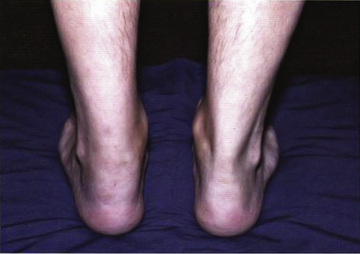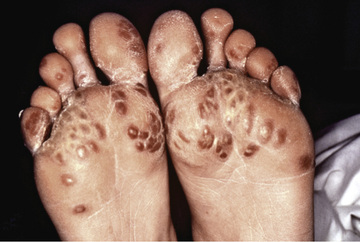Reactive and Postinfectious Arthritis
Pamela F. Weiss, Robert A. Colbert
In addition to causing arthritis by means of direct microbial infection (i.e., septic arthritis; see Chapter 705 ), microbes activate innate and adaptive immune responses, which can lead to the generation and deposition of immune complexes as well as antibody or T cell–mediated cross-reactivity with self. In addition, microbes may influence the immune system in ways that promote immune-mediated inflammatory diseases such as systemic lupus erythematosus (SLE), inflammatory bowel disease (IBD), juvenile idiopathic arthritis (JIA), and spondyloarthritis. Reactive arthritis and postinfectious arthritis are defined as joint inflammation caused by a sterile inflammatory reaction following a recent infection. We use reactive arthritis to refer to arthritis that occurs following enteropathic or urogenital infections and postinfectious arthritis to describe arthritis that occurs after infectious illnesses not classically considered in the reactive arthritis group, such as infection with group A streptococcus or viruses. In some patients, nonviable components of the initiating organism have been demonstrated in affected joints, and the presence of viable, yet nonculturable, bacteria within the joint remains an area of investigation.
The course of reactive arthritis is variable and may remit or progress to a chronic spondyloarthritis, including ankylosing spondylitis (see Chapter 181 ). In postinfectious arthritis the pain or joint swelling is usually transient, lasting <6 wk, and does not necessarily share the typical spondyloarthritis pattern of joint involvement. The distinction between postinfectious arthritis and reactive arthritis is not always clear, either clinically or pathophysiologically.
Pathogenesis
Reactive arthritis typically follows enteric infection with Salmonella species, Shigella flexneri, Yersinia enterocolitica, Campylobacter jejuni , or genitourinary (GU) tract infection with Chlamydia trachomatis . Escherichia coli and Clostridium difficile are also causative enteric agents, although less common (see Table 181.2 ). Acute rheumatic fever caused by group A streptococcus (see Chapters 182 and 210.1 ), arthritis associated with infective endocarditis (see Chapter 464 ), and the tenosynovitis associated with Neisseria gonorrhoeae are similar in some respects to reactive arthritis.
Approximately 75% of patients with reactive arthritis are HLA-B27 positive. Incomplete elimination of bacteria and bacterial products, such as DNA, has been proposed as a factor in reactive arthritis. A relationship with clinical characteristics of specific infectious disorders is not present. In postinfectious arthritis, several viruses (rubella, varicella-zoster, herpes simplex, cytomegalovirus) have been isolated from the joints of patients. Antigens from other viruses (e.g., hepatitis B, adenovirus) have been identified in immune complexes from joint tissue.
Patients with reactive arthritis who are HLA-B27 positive have an increased frequency of acute and symptomatic uveitis and other extraarticular features. In addition, HLA-B27 is a risk factor for persistent gastrointestinal (GI) inflammation following enteric infections, even after resolution of the initial infection, and significantly increases the risk that the individual will develop chronic spondyloarthritis. Nevertheless, reactive arthritis also occurs in HLA-B27–negative patients, emphasizing the importance of other genes in disease susceptibility.
Clinical Manifestations and Differential Diagnosis
Symptoms of reactive arthritis begin approximately 3 days to 6 wk following infection. The classic triad of arthritis, urethritis, and conjunctivitis is relatively uncommon in children. The arthritis is typically asymmetric, oligoarticular, with a predilection for lower extremities. Dactylitis may occur, and enthesitis is common, affecting as many as 90% of patients (Fig. 182.1 ). Cutaneous manifestations can occur and may include circinate balanitis, ulcerative vulvitis, erythematous oral macules or plaques or erosions, erythema nodosum, paronychia, painful erosions or pustules on fingertips, and keratoderma blennorrhagica, which is similar in appearance to pustular psoriasis (Fig. 182.2 ). Systemic symptoms may include fever, malaise, and fatigue. Less common features may include conjunctivitis, optic neuritis, aortic valve involvement, sterile pyuria, and polyneuropathy. Early in the disease course, markers of inflammation—erythrocyte sedimentation rate (ESR), C-reactive protein, and platelets—may be greatly elevated. The clinical manifestations may last for weeks to months.


Familiarity with other causes of postinfectious arthritis is vital when a diagnosis of reactive arthritis is being considered. Numerous viruses are associated with postinfectious arthritis and may result in particular patterns of joint involvement (Table 182.1 ). Rubella and hepatitis B virus typically affect the small joints, whereas mumps and varicella often involve large joints, especially the knees. The hepatitis B arthritis–dermatitis syndrome is characterized by urticarial rash and a symmetric migratory polyarthritis resembling that of serum sickness. Rubella-associated arthropathy may follow natural rubella infection and, infrequently, rubella immunization. It typically occurs in young women, with an increased frequency with advancing age, and is uncommon in preadolescent children and in males. Arthralgia of the knees and hands usually begins within 7 days of onset of the rash or 10-28 days after immunization. Parvovirus B19, which is responsible for erythema infectiosum (fifth disease), can cause arthralgia, symmetric joint swelling, and morning stiffness, particularly in adult women and less frequently in children. Arthritis occurs occasionally during cytomegalovirus infection and may occur during varicella infections but is rare after Epstein-Barr virus infection. Varicella may also be complicated by suppurative arthritis, usually secondary to group A streptococcus infection. HIV is associated with an arthritis that resembles psoriatic arthritis more than JIA (see Chapter 180 ).
Poststreptococcal arthritis may follow infection with either group A or group G streptococcus. It is typically oligoarticular, affecting lower-extremity joints, and mild symptoms can persist for months. Poststreptococcal arthritis differs from rheumatic fever, which typically manifests with painful migratory polyarthritis of brief duration. Because valvular lesions have occasionally been documented by echocardiography after the acute illness, some clinicians consider poststreptococcal arthritis to be an incomplete form of acute rheumatic fever (see Chapter 210.1 ). Certain HLA-DRB1 types may predispose children to development of either poststreptococcal arthritis (HLA-DRB1*01) or acute rheumatic fever (HLA-DRB1*16).
Transient synovitis (toxic synovitis) , another form of postinfectious arthritis, typically affects the hip, often after an upper respiratory tract infection (see Chapter 698.2 ). Boys 3-10 yr of age are most often affected and have acute onset of severe pain in the hip (groin), with referred pain to the thigh or knee, lasting approximately 1 wk. ESR and white blood cell count are usually normal. Radiologic or ultrasound examination may confirm widening of the joint space secondary to an effusion. Aspiration of joint fluid is often necessary to exclude septic arthritis and typically results in dramatic clinical improvement. The trigger is presumed to be viral, although responsible microbes have not been identified.
Nonsuppurative arthritis has been reported in children, usually adolescent boys, in association with s evere truncal acne. Patients often have fever and persistent infection of the pustular lesions. Pyogenic (sterile) arthritis, pyoderma gangrenosum, and acne (cystic) syndrome , an autosomal dominant disorder caused by a mutation in the PSTPIP1 gene, is a difficult-to-treat but rare autoinflammatory disorder that has responded to anakinra or anti–tumor necrosis factor antibody therapy in a few patients. Recurrent episodes of erosive arthritis begin in childhood; cystic acne and the painful ulcerating lesions of pyoderma gangrenosum begin during adolescence. Recurrent episodes may also be associated with a sterile myopathy and may last for several months.
Infective endocarditis can be associated with arthralgia, arthritis, or signs suggestive of vasculitis, such as Osler nodes, Janeway lesions, and Roth spots. Postinfectious arthritis, perhaps because of immune complexes, also occurs in children with N. gonorrhoeae, Neisseria meningitidis, Haemophilus influenzae type b, and Mycoplasma pneumoniae infections.
Diagnosis
A recent GU or GI infection may suggest the diagnosis of reactive arthritis, but there is no diagnostic test. A complete blood count, acute-phase reactants, complete metabolic panel, and urinalysis may be helpful to exclude other etiologies. Although stool or urogenital tract cultures can be performed in an attempt to isolate it, the triggering organism is not typically found at the time arthritis presents. Imaging findings are nonspecific or normal. Documenting previous streptococcal infection with antibody testing (anti-streptolysin O and anti-DNAse B) may help to diagnose postinfectious arthritis. Serum sickness associated with the antibiotic treatment of preceding infection must be excluded.
Because the preceding infection can be remote or mild and often not recalled by the patient, it is also important to rule out other causes of arthritis. Acute and painful arthritis affecting a single joint suggests septic arthritis, mandating joint aspiration. Osteomyelitis may cause pain and an effusion in an adjacent joint but is more often associated with focal bone pain and tenderness at the site of infection. Arthritis affecting a single joint, particularly the knee, may also be secondary to Lyme disease in endemic areas. The diagnosis of postinfectious arthritis is often established by exclusion and after the arthritis has resolved. Arthritis associated with GI symptoms or abnormal liver function test results may be triggered by infectious or autoimmune hepatitis. Arthritis or spondyloarthritis may occur in children with IBD, such as Crohn disease or ulcerative colitis (see Chapter 362.1 ). Parvovirus infection, macrophage activation (hemophagocytic) syndrome, and leukemia should be strongly considered when 2 or more blood cell lines are low or progressively decrease in a child with arthritis. Persistent arthritis (>6 wk) suggests the possibility of a chronic rheumatic disease, including JIA (see Chapters 180 ) and systemic lupus erythematosus (see Chapter 183 ).
Treatment
Specific treatment is unnecessary for most cases of reactive or postinfectious arthritis. Nonsteroidal antiinflammatory drugs (NSAIDs) are often needed for management of pain and functional limitation. Unless ongoing Chlamydia infection is suspected, attempts to treat the offending organism are not warranted. If swelling or arthralgia recurs, further evaluation may be necessary to exclude active infection or evolving rheumatic disease. Intraarticular corticosteroid injections may be given for refractory or severely involved joints once acute infection has been ruled out. Systemic corticosteroids or disease-modifying antirheumatic drugs (DMARDs) are rarely indicated but may be considered for chronic disease. Participation in physical activity should be encouraged, and physical therapy may be needed to maintain normal function and prevent muscle atrophy. For postinfectious arthritis caused by streptococcal disease, current recommendations include penicillin prophylaxis for at least 1 yr. Long-term prophylaxis is often recommended, but the duration is controversial and may need to be individualized.
Complications and Prognosis
Postinfectious arthritis following viral infections usually resolves without complications unless it is associated with involvement of other organs, such as encephalomyelitis . Children with reactive arthritis after enteric infections occasionally experience IBD months to years after onset. Both uveitis and carditis have been reported in children diagnosed with reactive arthritis. Reactive arthritis, especially after bacterial enteric infection or GU tract infection with C. trachomatis, has the potential for evolving to chronic arthritis, particularly spondyloarthritis (see Chapter 181 ). The presence of HLA-B27 or significant systemic features increases the risk of chronic disease.